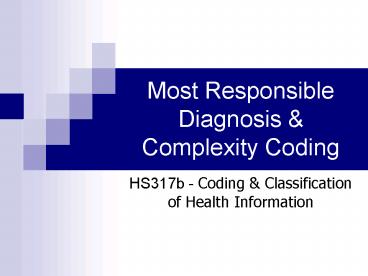Most Responsible Diagnosis - PowerPoint PPT Presentation
Title:
Most Responsible Diagnosis
Description:
PLX 9 - complexity & age split are inherent in the CMG so no need for further PLX ... Pre-operative anesthetic consult. Diagnosis Type 6. Proxy MRDx ... – PowerPoint PPT presentation
Number of Views:54
Avg rating:3.0/5.0
Title: Most Responsible Diagnosis
1
Most Responsible Diagnosis Complexity Coding
- HS317b - Coding Classification of Health
Information
2
MCC
4 Complexity levels
CMG
RIW
3
Complexity Levels
- PLX 1 - no complexity
- PLX 2 - complexity related to chronic conditions
- PLX 3 - complexity related to serious or
important conditions - PLX 4 - highest complexity - complexity related
to life-threatening conditions - PLX 9 - complexity age split are inherent in
the CMG so no need for further PLX
4
Complexity 9
- Assigned to
- MCC 14 Pregnancy Childbirth
- MCC 15 Newborns Neonates
- MCC 19 Mental Diseases Disorders
- MCC 24 HIV Infections
- MCC 25 (CMG 651-659, 674-679 only) Significant
Trauma - MCC 99 Ungroupable Data
5
Complexity Assignment
- Identifies other diagnoses (other than most
responsible diagnosis) which may prolong the
length of stay and/or the need for more costly
treatment.
6
Resource Intensity Weight
- Resource total hospital service cost including
fixed and variable components - Intensity the amount of service utilized
- Weight relative value of each case compared to
the average case which is the value of 1
7
Resource Intensity Weight (RIW)
- A statistical cost which recognizes that not
every patient consumes the same resources during
their stay in hospital. - Resources can differ due to
- Differences in LOS
- Types of resources used (medical/surgical)
- Nursing intensity, etc.
8
Categories of patients
- Typical patient who receives a fully successful
course of treatment in a single institution and
is discharge when they no longer require the
services of an acute care hospital - Atypical patient who exhibits a different
pattern of care either because they do not
complete a successful course of treatment in a
single hospital visit or because the LOS is
greater than the statistical trim point for
CMG/Plx Level (examples sign-outs, death,
transfers, long stay outliers)
9
Comorbidity conditions
- Identify other diagnosis to indicate 5 complexity
levels - only 465 codes that impact complexity
level - Significantly impacts complexity levels and RIWs
10
Comorbidities
- All conditions that coexist at the time of
admission or develop subsequently demonstrate - Significantly affects the treatment received
- Requires treatment beyond maintenance of the
pre-existing condition - Increases the LOS by at least 24 hours
11
How to determine significance?
- Documented evidence in physicians
notes/discharge summary that - Clinical evaluation/consultation document a new
or amended course of treatment - Therapeutic treatment/intervention with a code
assignment of 50 or greater from Section 1 of
CCI - Diagnostic intervention, inspection or biopsy
with a code assignment from Section 2 of CCI - Extended the LOS by at least 24 hours
12
Post procedural condition
- Documented by physician as a complication of the
procedure - Present at discharge
- Persist post-procedurally for at least 96 hours
13
Valuable tools for coding
- Nurses notes
- Pathology reports
- Laboratory reports
- Autopsy reports
- Medication profiles
- Radiological investigations
- Nuclear imaging
- etc
14
Comorbid Conditions Identification
- A one digit number or letter to identify the
relationship of the diagnosis to the patients
stay in hospital - Diagnosis type 1, 2, 3, 4, 6, 9, 0, W, X, Y
15
Diagnosis type 1
- Pre-Admit Comorbidity
- A condition that existed pre-admission
- Satisfies the requirements for determining
comorbidity
16
Diagnosis type 2
- Post-admit Comorbidity
- A condition that arises post-admission
- Satisfies the requirements for determining
comorbidity
17
Diagnosis Type 3
- Secondary Diagnosis
- A condition or diagnosis which may or may not
have received treatment - Does not satisfy the requirements for determining
comorbidity - Some codes require a diagnosis type 3
18
- Diagnosis type 3 conditions are coded if they are
listed on the - Front sheet
- Discharge summary
- Death certificate
- History physical
- Pre-operative anesthetic consult
19
Diagnosis Type 6
- Proxy MRDx
- It is assigned to an asterisk code, the
manifestation in a dagger/asterisk convention
when it fulfills the requirements stated in the
definition of MRDx. - Can only apply diagnosis type 6 to the second
line of a diagnosis field of the abstract. - Only one asterisk code is allowed a diagnosis
type 6 per encounter.
20
Diagnosis type W, X, or Y
- Service Transfer Diagnosis
- A diagnosis associated with the
first/second/third service transfer - Recording the days spent under another patient
service
21
Diagnosis Type 4 Morphology Codes
- Morphology codes derived form ICD-O codes
describing the type and behaviour of neoplasm
22
Diagnosis type 9 External Cause of Injury code
- Mandatory to use with codes in the range of
S00-T98, injury, poisoning and certain other
consequences of external causes - Category U98., Place of Occurrence
- Mandatory with codes in the range of W00-Y34
- Exception Y06 Y07
23
Diagnosis Type 0
- Use to distinguish babies born via caesarean
section from those born vaginally - Application code range is Z38. Liveborn infants
according to place of birth P03.4 Fetus and
newborn affected by caesarean delivery
24
Goals for Coding
- To distinguish between the diagnosis type
categories used in DAD coding/abstracting
correctly apply them - To interpret apply the Canadian Coding
Standards for ICD-10-CA CCI - To recognize the importance of consistent
application of standards to data quality
25
Abstract with CMG MCC Assignment
Plx Level
Plx to MCC or CMG
9
Yes
Complexity not applicable
Yes
4
Complexity related to life threatening
Vent gt 96 hours
26
Presence of Service Transfer or CC Diagnoses
N0
1
No Complexity
Eliminate Duplicate Dx
Assign Grades to Each Dx
Assign Plx Level































